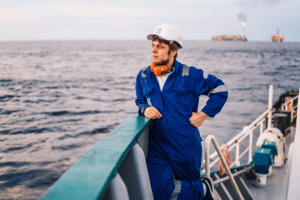The Longshore Harbor Workers’ Compensation Act (LHWCA)is a federal workers’ compensation act which gives uniform protection and health care to maritime employees that don’t perform the duties of seamen. The U.S. Department of Labor’s Office of Workers’ Compensation Plans (OWCP) administers the allocation of LHWCA benefits via the Division of Longshore and Harbor Workers’ Compensation (DLHWC). A maritime worker must fulfill various requirements in order for employees to qualify for LHWCA benefits for their on-the-job injuries. These requirements are established in Sections 2(3) and 3(a) of the LHWCA. Section 2(3) defines what types of tasks qualify a maritime worker for coverage, while Section 3(a) defines where the tasks are performed. These two sections are known as the status and situs tests.

Status Test
The status test establishes what jobs or tasks can be considered in order for an injured marine worker to receive LHWCA benefits. Generally speaking, maritime employees can file a claim for a job-related injury if they are:
- Longshoremen
- Waterfront crane operators
- Longshore checkers
- Stevedores
- Terminal workers
- Shipyard employees
- Shipbuilders
- Marine construction workers
- Vessel repair workers
Congress extended LHWCA coverage to certain workers with several amendments. There are three current extensions to the law:
- The Defense Base Act (DBA), which covers non-Defense Department civilian employees and outside contractors who work in military bases overseas, including in Iraq and Afghanistan
- The Outer Continental Shelf Lands Act (OCSLA), which covers certain workers employed on oil wells, natural gas wells, and other offshore facilities connected with the exploration, exploitation, removal, and transportation of natural resources from the Outer Continental Shelf
- The Nonappropriated Fund Instrumentalities Act (NFIA), which covers civilians employed in post exchanges in military bases and individuals contracted to boost the morale of U.S. military personnel
The LHWCA doesn’t cover all maritime workers. It excludes crew members and masters of vessels, who are already protected by the Jones Act. Other marine industry workers fail the law’s status test if they are:
- Clerical workers, receptionists, secretaries,security guards, data processors and other employees who perform general office-related tasks
- Maritime workers whose injuries occurred while they were intoxicated
- Maritime workers who intend to deliberately hurt themselves or others
- Officers and other employees of the U.S. government, as well as officers and employees of foreign governments
In addition, individuals who work in business establishments located near harbors, ports, shipyards and other maritime facilities and are covered by their state’s workers’ compensation plan don’t qualify for LHWCA benefits. These workers include:
- Employees of camps, restaurants, clubs, museums, retail stores, or recreational operations
- Marina employees who do not participate in constructing, replacing, or expanding such marina.
- Temporary workers in a maritime company
- Employees of transporters, suppliers, or vendors
- Aquaculture workers
- Workers hired to build, repair, or dismantle recreational vessels less than 65 feet in length or have displacements less than 18 tons net
- Workers on small vessels exempted by a certificate from the Secretary of Labor under certain circumstances
Situs Test
When the LHWCA was passed into law in 1927, it only applied to maritime employees who were injured while working upon the navigable waters of the United States. This limited claims to longshoremen who were aboard a vessel when they were injured on the job. This forced injured workers to settle for smaller state-issued workers’ compensation payouts if they had been hurt on land instead of a vessel on navigable waters. Thus, Congress amended LHWCA to cover non-seaman marine workers on the water and any of the following:
- Piers
- Wharves
- Drydocks
- Terminals
- Building ways
- Marine railways
- Oil rigs, natural gas drilling platforms, and other offshore structures under OCSLA jurisdiction
The LHWCA also covers employees who are injured while working in any adjoining area normally used to load, unload, repair, or build a vessel. This includes repair facilities like floating dry docks, which travel on water but are normally moored on or close to land. Non-seaman employees assigned to floating drydocks qualify for benefits under LHWCA because the structures fall into the definition of “adjoining area” customarily used by employees to repair vessels.
If an injured maritime worker meets the OWCP status and situs requirements, he is entitled to temporary financial benefits that equal two-thirds of an individual’s average weekly salary while undergoing medical treatment. LHWCA also provides prescription medicines, crutches, nursing assistance, prostheses, hearing aids, and other services. In addition, the law gives survivor benefits to the employee’s family in case of death.